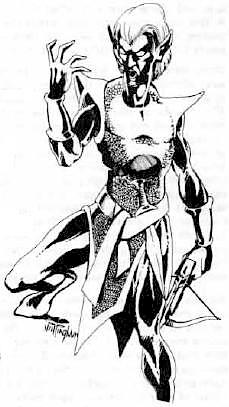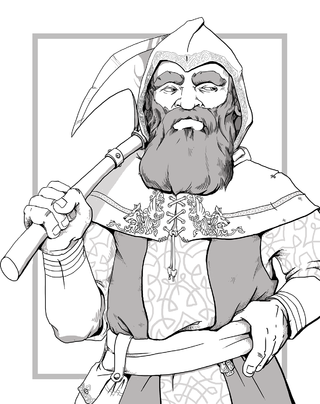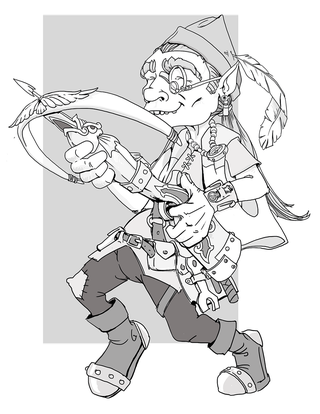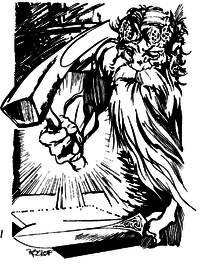
The drow or dark elves are a dark-skinned and white-haired subrace of elves connected to the subterranean Underdark in the Dungeons & Dragons fantasy roleplaying game. The drow have traditionally been portrayed as generally evil and connected to the evil spider goddess Lolth. However, later editions of Dungeons & Dragons have moved away from this portrayal and preassigned alignment. More recent publications have explored drow societies unconnected to Lolth.

Vecna is a fictional character appearing in the Dungeons & Dragons fantasy role-playing game. Vecna has been named one of the greatest villains in the Dungeons & Dragons franchise.
Faerûn is a fictional continent and the primary setting of the Dungeons & Dragons world of Forgotten Realms. It is described in detail in several editions of the Forgotten Realms Campaign Setting with the most recent being the 5th edition from Wizards of the Coast, and various locales and aspects are described in more depth in separate campaign setting books. Around a hundred novels, several computer and video games and a film use Faerûn as the setting.

Deities & Demigods, alternatively known as Legends & Lore, is a reference book for the Dungeons & Dragons fantasy role-playing game (D&D). The book provides descriptions and game statistics of gods and legendary creatures from various sources in mythology and fiction, and allows dungeon masters to incorporate aspects of religions and mythos into their D&D campaigns.
Mystra is a fictional goddess in the Forgotten Realms campaign setting for the Dungeons & Dragons fantasy role-playing game.
Birthright is a Dungeons & Dragons campaign setting that was first released by TSR in 1995. It is based on the continent of Cerilia on the world of Aebrynis, in which the players take on the role of the divinely-empowered rulers, with emphasis on the political rulership level of gameplay. The setting revolves around the concept of bloodlines: divine power gained by heroes and passed to their descendants. Characters with a bloodline create an aura of command known as Regency, which is measured in the game using regency points or RP. Using regency, characters acquire a domain composed of provinces and holdings. The development of these domains is as much a part of the game as development of the characters. The game uses three-month domain turns to model actions of rulers over nations in much the same way as Dungeons & Dragons uses combat rounds to simulate time to model the characters' actions in battle. In 1996, Birthright won the Origins Award for Best Roleplaying Supplement of 1995.
Al-Qadim is a campaign setting for the Dungeons & Dragons role-playing game which was developed by Jeff Grubb with Andria Hayday for TSR, Inc., and was first released in 1992. Al-Qadim uses One Thousand and One Nights as a theme and is set in the land of Zakhara, called the Land of Fate. Thematically, the land of Zakhara is a blend of the historical Muslim Caliphates, the stories of legend, and a wealth of Hollywood cinematic history. Zakhara is a peninsula on the continent of Faerûn in the world of Toril, the locale of the Forgotten Realms campaign setting, although Al-Qadim is designed to stand on its own or be added to any existing campaign setting. The basic campaign setting was divided between two game products: Al-Qadim: Arabian Adventures, a sourcebook describing character creation rules, equipment, and spells unique to the setting, and Al-Qadim: Land of Fate, a boxed set describing the land of Zakhara, with separate sourcebooks for the players and the Dungeon Master.

Tiamat is a supremely strong and powerful 5-headed draconic goddess in the Dungeons & Dragons role-playing game. The name is taken from Tiamat, a goddess in ancient Mesopotamian mythology. She is the queen and mother of evil dragons and a member of the default pantheon of Dungeons & Dragons gods. Her symbol is a five-headed dragon.

A dwarf, in the Dungeons & Dragons (D&D) fantasy roleplaying game, is a humanoid race, one of the primary races available for player characters. The idea for the D&D dwarf comes from the dwarves of European mythologies and J. R. R. Tolkien's novel The Lord of the Rings (1954-1955), and has been used in D&D and its predecessor Chainmail since the early 1970s. Variations from the standard dwarf archetype of a short and stout demihuman are commonly called subraces, of which there are more than a dozen across many different rule sets and campaign settings.
In the Dungeons & Dragons fantasy roleplaying game, Tharizdun is the god of Eternal Darkness, Decay, Entropy, Malign Knowledge, Insanity, and Cold. He originated in the World of Greyhawk campaign setting but has since also appeared in other settings.

In the Dungeons & Dragons role-playing game, orcs are a primitive race of savage, bestial, barbaric humanoid.

In the Dungeons & Dragons (D&D) role-playing game, Bahamut is a powerful draconic deity, who has the same name as Bahamut from Arabic mythology.

Faiths and Pantheons is a campaign accessory for the 3rd edition of the Dungeons & Dragons, for the Forgotten Realms campaign setting.
The legion of fictional deities in the World of Greyhawk campaign setting for the Dungeons & Dragons fantasy roleplaying game covers an extensive range of spheres of influence, allowing players to customize the spiritual beliefs and powers of their characters, and as well as giving Dungeon Masters a long list of gods from which to design evil temples and minions. Although the Greyhawk campaign world, when it was merely a home game, started with no specific gods, the value of having deities available for both players and game plot purposes was quickly realized. The number of deities has varied with each version of the campaign world that has been published, but for many years numbered a few dozen. It has only been since 1999 that the number of gods increased dramatically to almost 200, due to the volume of newly published material that was subsequently integrated into the campaign world.

Monster Mythology, published by TSR in 1992, is a sourcebook about non-human deities that can be used in fantasy role-playing games using the second edition rules for Advanced Dungeons & Dragons (AD&D).
Julia Martin is a game designer and editor who has worked on a number of products for the Dungeons & Dragons fantasy roleplaying game.

In the Dungeons & Dragons role-playing game, Corellon Larethian is the leader of the elven pantheon, and the deity of Magic, Music, Arts, Crafts, Poetry, and Warfare. Corellon is also considered a member of the default D&D pantheon. Corellon is the creator and preserver of the elven race, and governs those things held in the highest esteem among elves. Corellon's symbol was originally a crescent moon; in the 4th edition Corellon's symbol is a silver star on a blue field.

In the Dungeons & Dragons fantasy role-playing game, gnomes are one of the core races available for play as player characters. Some speculate that they are closely related to dwarves; however, gnomes are smaller and more tolerant of other races, nature, and magic. Depending on the setting and subrace, they are often skilled with illusion magic or engineering. Gnomes are small humanoids, standing 3–3.5 feet (91–107 cm) tall.









